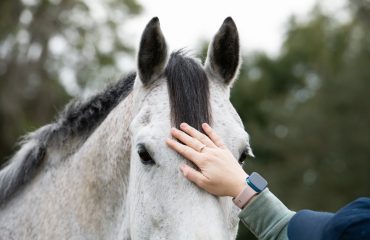
Richard Wheeler, DVM, was born in the U.K. and graduated from the Royal Veterinary College, London, in 2002. Dr. Wheeler then completed a two-year internship at Greenwood, Ellis and Partners (now Newmarket Equine Hospital) in Newmarket. In 2005, he moved to Wellington, Florida, to join Palm Beach Equine Clinic and he became a partner in 2009. Dr. Wheeler’s primary concentration is equine sports medicine. He is an FEI Veterinary Delegate for Show Jumping and Dressage and has authored several published articles on the topic of equine sports medicine. Dr. Wheeler has served on the board of the USHJA Horse and Rider Advocates Committee. In 2016, Dr. Wheeler became a founding director of the Sport Horse Research Foundation. Dr. Wheeler and his wife, Jessica, have two children. Do you have a question you want Dr. Wheeler to answer? Send questions to editor@sidelinesnews.com.
My horse’s stifle seems to lock every once in a while. We did an x-ray and nothing came up. Do you have any suggestions of what I should do next?
First, I recommend a lameness exam by your veterinarian to rule out other issues and confirm a diagnosis of upward fixation of the patella. This condition is related to the horse’s stay apparatus which allows a horse to rest while standing up. The mechanism involves the patella (kneecap) being hooked over the medial trochlear ridge of the femur, in order to stabilize the stifle. Normally the horse will use muscles to release the patella and resume normal function. When upward fixation occurs, the medial patellar ligament remains hooked over the medial trochlear ridge; clinically the leg appears locked in extension and horses may appear agitated.
In my experience, upward fixation of the patella has been seen in either young horses or those who have reduced musculature, such as following stall rest for another medical condition. I’ve seen some horses that occasionally ‘lock’ their stifle and can release it themselves easily. I’ve seen others who remain ‘locked’ for hours and even days and have to be manipulated in order to release.
In some cases, successful treatment has been achieved by adjusting the exercise and training program. If this isn’t enough, there are various medical options including farrier, systemic medications, intra-articular medication and injection of counterirritants. Occasionally, when other more conservative options have been exhausted, surgical intervention may be deemed necessary. Surgical techniques involve either splitting (desmoplasty) or cutting (desmotomy) the medial patellar ligament. While these techniques can be curative, I’d recommend careful discussion with your veterinarian regarding the potential side effects.
My horse appears to be experiencing pain in her shoulder. I am not sure what it is, but there are no visible marks, bruises or swelling. She does appear to have unusual movements and lameness. How can my vet investigate this further?
As with any lameness examination, the first step is to localize the site of pain and/or injury. This, in some cases, is straightforward and easily apparent. In other cases, this can be challenging and time-consuming. My typical lameness exam starts with a discussion with the owner, rider and/or trainer. We discuss the horse’s current level of training and look for clues with regard to performance and if there have been any recent episodes that may have contributed to the issue. With regard to more subtle issues, important information can be determined, such as if the horse is favoring one lead or another while jumping or having issues in particular lateral movements. The next step is to evaluate the horse; first, at rest, we look at the overall condition along with any visible abnormalities such as muscle loss and asymmetry. Next, we palpate the limbs feeling for heat, pain and swelling. In many cases, by this point we have something to go on, while in some cases, even with moderate lameness, there may be very little to see.
With an experienced eye, the characteristics of lameness can tell you a lot: how the lameness manifests itself and how it is exacerbated by manipulation such as flexion tests.
Diagnostic local analgesia, commonly called ‘nerve blocks,’ is a vital component of most lameness exams and can be very rewarding, although patience is required. This technique involves the selective use of local analgesic medication (similar to what is used in the dentist’s office) to numb regions of the leg in order to identify which structures are causing the lameness. Then we will either inject around nerves that innervate specific structures or areas of the leg, or we will inject directly into synovial structures such as joints, tendon sheaths and bursas. If the lameness is abolished following the ‘block,’ we know the specific area is involved in causing the lameness.
Once the lameness has been isolated to a particular region, diagnostic imaging techniques are used to investigate further. This may include radiographs and ultrasounds, which can usually be done at the farm, and in some cases more advanced techniques such as nuclear scintigraphy, MRI and CT.
 A few months ago, my family and I acquired a new horse from Europe. He was very skinny when he got to us, but because of how young he was we didn’t think anything of it. Since then, he hasn’t been able to put on weight. Other than the weight issue, he’s bright, alert and attentive. What else can we do to put weight on him?
A few months ago, my family and I acquired a new horse from Europe. He was very skinny when he got to us, but because of how young he was we didn’t think anything of it. Since then, he hasn’t been able to put on weight. Other than the weight issue, he’s bright, alert and attentive. What else can we do to put weight on him?
This is an issue we deal with often, as horses arrive in a new country after a long journey and lose condition. My approach to such cases is to make a list of possible causes and work through the list starting with the most simple. First I would perform a physical exam including examination of the teeth, and evaluate the feeding, exercise and parasite control regime. If we don’t get an answer from the examination, it may be useful to run simple blood tests and a fecal exam to investigate internal parasites. If we find an indication, we may look further for evidence of problems in the gastrointestinal tract, such as ulcers. Gastroscopy (looking into the stomach with a small camera) and ultrasound of the abdomen can be performed easily under light sedation. It may take a few months to get the horse to the ideal condition.
Recently I noticed lumps on my horse’s back. She isn’t scratching but our local vet mentioned that they could be protein bumps. What are protein bumps, what causes them and how can we treat them?
I believe you may be referring to collagen granuloma. While we’re not 100 percent sure what causes these skin masses, we believe they’re often an immune reaction to insect bites. They’re generally firm, raised nodules that are not itchy or painful, unless in some cases where the tack interferes with them. If further diagnostic tests are required, a sample can be taken via a needle (fine needle aspirate) or biopsy. There are a variety of approaches to treatment depending on size, number of lesions and their location. In my experience, they usually don’t resolve on their own, but some will be well-tolerated without treatment. If caught early, I’ve had some resolve with systemic corticosteroid treatment while others require direct injection of corticosteroid. In some cases where steroid treatment has not been successful, surgical removal may be necessary.
When presented with a horse with multiple granulomas, I think it’s important to try and address the cause; if we believe insect hypersensitivity is likely, I’d recommend avoiding the horse’s exposure to insects and consider allergy testing and potentially hyposensitization.













